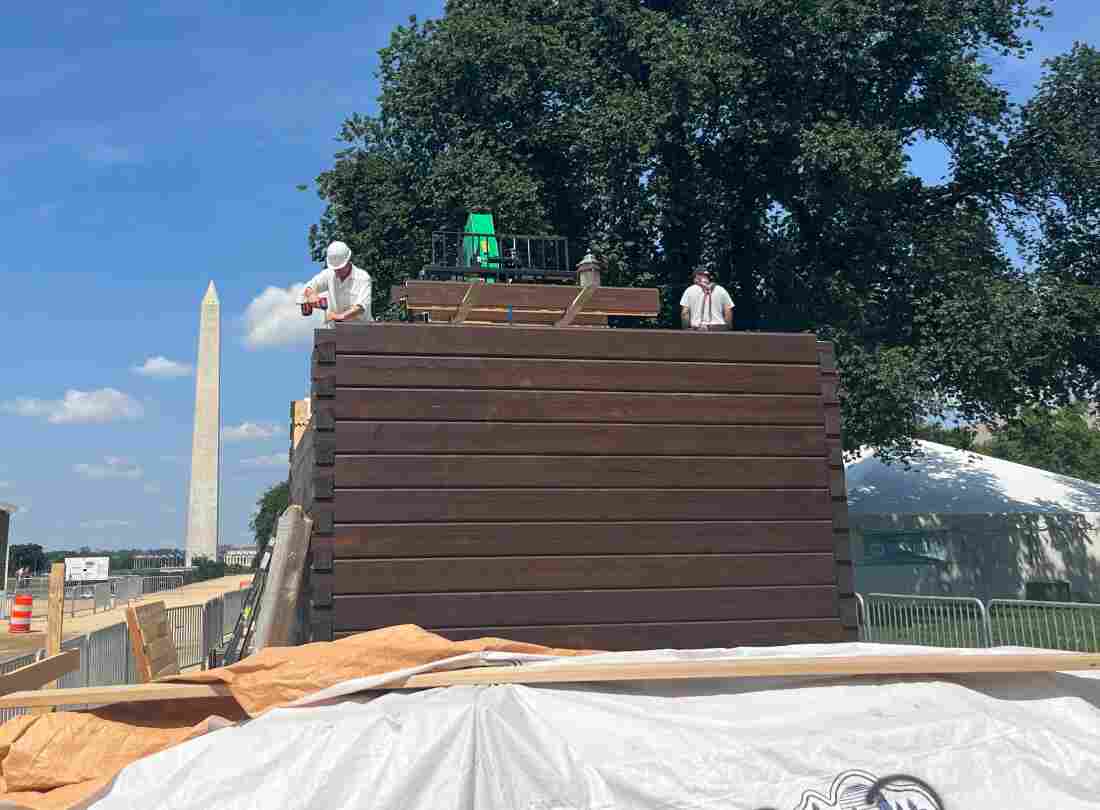Business
Homes have popped up on the National Mall – showing they can be built fast and cheap
This week, the National Mall in D.C. is sprouting something different: houses
3:26
Workers assemble a home resembling an instant log cabin on the National Mall in Washington, D.C., with the Washington Monument behind them.
Laurel Wamsley/NPR
hide caption
toggle caption
Laurel Wamsley/NPR
WASHINGTON — On the wide open, grassy space on the National Mall, halfway between the U.S. Capitol and the Washington Monument, a temporary village has sprouted up in recent days. Several tiny houses line the paths, and workers assemble what looks like an instant log cabin. A few manufactured homes are clustered near the Smithsonian Castle.
This is the Innovative Housing Showcase, staged by the U.S. Department of Housing and Urban Development (HUD), a public event running June 7-9.
Acting HUD Secretary Adrianne Todman said one of ways to make housing more affordable is simply to build more of it.
./HUD
hide caption
toggle caption
./HUD
At a preview on Tuesday, Acting HUD Secretary Adrianne Todman said the event is about offering a glimpse of the future — and showing ways to expand the country’s housing supply.
“We know that access to a home is one of the most pressing things for families across the country, whether you’re renting or wanting to become a first-time homebuyer. And one of the ways that we know to bring down costs is to just build more housing,” said Todman. “Just build more. Build, build, build!”
Tom Perez, the former Secretary of Labor who’s now senior advisor to President Biden, said housing is top of mind for the Biden administration. “When I think about the meetings that we’ve had at the White House recently, the issue of housing has been either the most or second-most discussed issue,” he said.
Manufactured homes produced by Cavco demonstrate newly-permitted duplex models.
Laurel Wamsley/NPR
hide caption
toggle caption
Laurel Wamsley/NPR
The backdrop to the speeches was a bright, stylish manufactured home, what used to be known as a mobile home. The innovation? It’s a duplex. HUD sets national building standards for manufactured homes, and recently changed its code to allow homes like this.
“So this is one unit, and it’s separated by a firewall for a second unit. So instead of having an opportunity for one family, we now have an opportunity for two families to live affordably,” Todman explained, standing inside the home.
Richard Smith is a sales manager at Cavco, the company that built this home. A duplex like this might be used in infill areas where space is at a premium. “It allows us to get more affordable homes,” Smith says. “So it really just helps a piece of solving the affordable housing crisis.”
Cavco’s Richard Smith says in some rural areas, manufactured homes might be the only new housing that’s available.
Laurel Wamsley/NPR
hide caption
toggle caption
Laurel Wamsley/NPR
He says one reason they’re at this event is to show that there could be a place for homes like this in more urban areas, while they continue to meet real needs elsewhere.
“Especially in the rural areas, this is really the only opportunity for folks to have new housing. You just don’t have the tradespeople, the developers that want to go into smaller, more rural areas. That’s a real niche that we serve, but we can serve a whole lot more than that,” says Smith.
The interior of one side of the duplex manufactured home.
Laurel Wamsley/NPR
hide caption
toggle caption
Laurel Wamsley/NPR
A tiny house made from a shipping container arrives on the Mall, transported by truck.
Laurel Wamsley/NPR
hide caption
toggle caption
Laurel Wamsley/NPR
Further along the Mall stands a two-story, traditional-looking house that wasn’t here two days ago. The framing is done, and it’s ready for siding and a roof.
It’s here to demonstrate how using prefabricated materials can speed the construction of a home. Mark Cyrus, who’s in sales with 84 Lumber, says once the materials were trucked in, the house was fully framed in a little under six hours.
Mark Cyrus, who works for 84 Lumber, stands in front of a home that that was framed in about six hours using prebuilt materials — a job that often takes two weeks with traditional materials.
Laurel Wamsley/NPR
hide caption
toggle caption
Laurel Wamsley/NPR
“The innovation is the floor cassettes that are pre-manufactured offsite, the longer walls with windows in them, and then the roof cassettes. So when it comes in, it’s literally — they’re not building nothing. They’re just putting together kind of a puzzle,” explains Cyrus.
With typical stick framing, it would often take two weeks to do all this. But using these materials — like the prebuilt flooring sections — cut that time way down.
The U.S. Capitol Building is seen through an upstairs window of the quickly-constructed house.
Laurel Wamsley/NPR
hide caption
toggle caption
Laurel Wamsley/NPR
That’s a big deal, because for developers, the time before a project’s completed costs big money — and that gets passed along to the homebuyer.
“For builders is all about cycle time. Cycle time is how quick you can build a house,” says Cyrus. And the faster they can build the house, “the more affordable they can give houses to the American people.”
